Questions to Ask When Salvaging Components
|
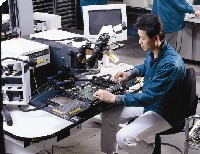
|
|
|
Figure 1: Controlled hot air rework machine for safe component removal.
|
Have you heard this one before? A manager walks into a meeting and is told that there is one million dollars worth of circuit assemblies that are scrap because of ... fill in the blank. Yee Gads! How could that happen? There are a whole lot of reasons why circuit boards are scrapped, and it is safe to say that none of them are good.
At Circuit Technology Center we're in the business of saving circuit boards. We're able to correct most levels of design and fabrication errors or physical damage that would cause a circuit board to be scrapped.
However, there are circumstances beyond rework and repair that cause a circuit board to become non-functional. Does that make that circuit board worthless junk? Maybe not.
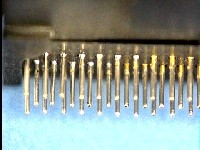
|
|
|
Connector pins free of conformal coating on solderable contact area.
|
In the unfortunate event a board is no longer useful you still may wish to salvage some of the more valuable components for reuse elsewhere.
The Mechanics of salvage
Disassembly of faceplates and hardware is a fairly routine operation; the careful use of a screwdriver and nut-driver or two will quickly net a cost-saving inventory of valuable material for future applications.
Recovering the soldered components from the board safely, and in a condition for reuse is a bit more challenging, however, component salvage or reclamation is becoming more commonplace and the value of many of these components provides easy justification for the effort associated with reclaiming them.
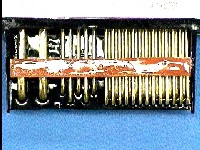
|
|
|
Conformal coating remains on connector body and leads beyond the critical contact area.
|
When reviewing applications for component salvage it is important to understand all of the requirements. "The devil is in the detail" certainly holds true here; sometimes the littlest things can complicate the process. Important questions to ask yourself when considering a salvage project.
What environmental elements have the circuit boards and components been exposed to? What is the moisture sensitivity level?
If the circuit boards and components were newly assembled, and have been in a controlled environment then it will probably eliminate the need to bake the components prior to exposure to the reflow process for removal from the circuit boards.
If the circuit boards have been held in open storage, or are field returns, or the moisture sensitivity level of the components deems it necessary, a pre-bake of the components will be required prior to exposure to reflow temperature to eliminate damage due to moisture entrapment.
Are the circuit boards and components conformally coated or is there an under-fill applied?
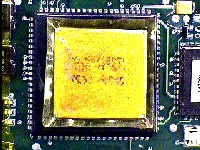
|
|
|
Component label masked with insulation to prevent exposure to hot air during the removal process.
|
The impact conformal coating and under-fill have on the component salvage process can be significant. The coating type and the stripping process could easily over-burden the reclamation effort.
It is also important to determine the overall area of the component that the coating must be removed from. In most cases the critical area is relegated to the solderable surface of the component lead, not the component body.
Are there labels for marking the components that may not withstand the heating or cleaning cycle?
Sometimes there are labels or other marking on the components that must be protected to prevent discoloration from the reflow process or removal from the cleaning process. Masking those locations with tape or an insulator may be required to avoid this pitfall.
What is the ESD sensitivity level?
It's assumed that all components should be handled with proper ESD precautions. There are different levels of ESD sensitivity, and understanding the components that you are working with is important. The component specification sheet will normally provide the level of detail you'll need.
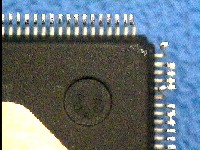
|
|
|
Component leads in need of touch-up to remove residual solder, and straighten deformed leads.
|
What temperature range can the component withstand?
Component salvage can be completed with a variety of processes consisting of localized hot air, molten solder on mini-wave machine, as well as conduction heat from a soldering iron, or desoldering tool.
All relatively sound processes when performed by a trained operator. A review of the component specification will provide a safe temperature range to maintain.
Will the components be machine, or hand placed in the upcoming re-assembly process?
It is important to know the assembly process to be used with the salvaged components. If the salvaged components are to be hand soldered, as opposed to machine placed, then the criteria for residual solder left on the leads, and lead co-planarity can be loosened a bit. Less component touch-up time means a less costly salvage process for you. If you prefer to use placement machines and your normal assembly process, the components may need to go through robotic lead refinishing.
What about packaging, trays, tubes or tape and reel?
Often overlooked is the need for safe packaging of the salvaged components. There are several companies that can supply new trays and tubes for safe storage.
There is also the ability to have the components tape and reeled for machine placement processes. Once again, the component specification will provide the dimensional information for selecting the correct material. Anti-static, or conductive foam can be used for power supplies or unusual component configurations when custom packaging is not readily available.
Answering these questions will help in establishing the quality requirements and set the stage for a successful recovery process.
Several members of the Circuit Technology Center team contributed to this feature story.
|
|
|
|
|